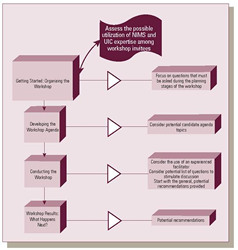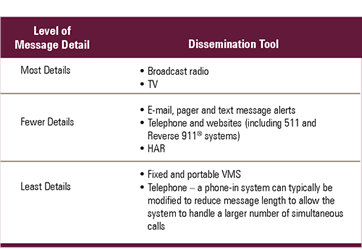
A toolkit provides agencies involved in transportation management, emergency management, and traveler information with a brief and focused set of the items necessary to develop a strategy for providing accurate and useful information to the public during times of disaster. The toolkit is meant to be general: something that can be taken to any region, metropolitan area, or state and used as a template or blueprint for creating a consensus on how a region can use its ATIS assets during a disaster.
Covered in the toolkit are the institutional processes for contacting the agencies and suggestions of the personnel, or the types of people, necessary in times of disaster to distribute and disseminate proper information in the most efficient way possible. The toolkit is meant to serve as a “jumping off” point for regions and/or metropolitan areas, even states, to organize workshops to address the issues faced during times of disaster in the communication of information to the public, using ATIS. The major components of the toolkit and the process for organizing a workshop to develop an ATIS strategy are outlined in Figure 5-1.

Figure 5-1. Toolkit for Developing an ATIS Strategy
By tailoring the ideas in the toolkit to local needs, workshop participants can create a cohesive strategy, informed by the input of all involved, which allows a region, metropolitan area, or state to use available ATIS assets to aid the public to the greatest extent possible.
Getting Started: Organizing the Workshop
Initial questions that need to be answered during the planning stages of the workshop include:
Who organizes the workshop? What agency and/or individual(s) with the appropriate level and skills can be called upon to organize the workshop? Is a subcommittee needed with representatives from a few agencies to get buy-in to the workshop concept and to tap their knowledge and resources?
When and where will the workshop take place? Consider the needs and travel arrangements of all invited participants, as well as a room layout that is conducive to interaction.

Who participates: what agency and what type of person? This toolkit offers some lists of personnel/agencies that should be considered when bringing together a complete set of participants for a workshop. Potential workshop invitees include:
Emergency Planning, Management, and Response
- State Department of Public Safety or State Department of Emergency Management
- County Emergency Management personnel
- City Emergency Management personnel
- Incident Commander
- Fire Chief and subordinates
- Police Chief and subordinates
- Reverse 911® Coordinator
- Public Information Officer
- MPO personnel involved in emergency management
- FEMA
- Department of Homeland Security
- FBI
- Military Installations (National Guard, DOD)
- Companies involved in HAZMAT transportation and/or production
Transportation Management
- County Transportation agencies
- City Departments of Transportation
- State DOT Traffic Management Center Managers
- ITS Coordinator
- ATIS Coordinator
- Public Information Officer
- Transit Agency Managers
- MPO personnel involved in transportation management
Media and Other Private Sector
- Television stations
- Radio stations
- Dedicated traffic information services
- Internet informational websites
- HAM radio associations
Who facilitates the workshop and who serves as recorder during the workshop? The roles of facilitator as well as those who will be recording the proceedings should be decided beforehand and included in the information distributed to invited attendees.
What information should be prepared in advance that will be needed at the workshop? Examples include material from after-action reports or a scenario for a tabletop exercise. Invited attendees can be asked to bring potentially needed or reference materials to the workshop.
Developing the Workshop Agenda
Depending upon how long the workshop is intended to be, an agenda needs to be structured not only to ensure that all the intended topics are covered, but also to keep the participants engaged and contributing to the discussion. Another consideration is how much preparatory work the organizer(s) decides to do prior to the workshop. An agenda developed for a workshop for which there is minimal advanced work can be positioned as a session for the participants “to get their arms around” the topic. In that case, the agenda could be designed to let the audience become the source of the technical information and identify gaps in knowledge and processes that can be worked on after the workshop.
On the other hand, the agenda could incorporate prepared materials, if the organizers choose to invest time in such preparations. For example, subject matter experts could give short presentations on specific topics for discussion, or scenarios could be developed for participants to conduct a tabletop exercise, or other similar materials could be prepared.
There is no right or wrong method, but it is up to the organizers to decide what best fits with local needs. The objective is to begin the process of development of a strategy by getting the appropriate stakeholders involved in discussion. Shown in Table 5-1 is a list of general issues that should be considered in the workshop agenda.
Conducting the Workshop
Effectively run workshops require good facilitation and recording of results. A good facilitator keeps the discussion on track with the agenda and time available and provides an opportunity for all participants to provide input and stay engaged in the discussion. Equally important is to have a written record of the discussion for follow-up actions. It is highly recommended that a minimum of two individuals are identified for these separate roles. If resources allow, organizers should consider the use of an experienced facilitator. Multi-jurisdictional workshops can benefit from the presence of a professional facilitator, specifically not associated with any of the agencies sponsoring the workshop. This can make participants feel that no one agency will take precedence in the discussions, and neither benefits nor resource allocation will fall too heavily on one agency. If resources don't permit hiring a facilitator, an alternative would be to enlist an agency employee who does not have a direct stake in the subject matter (or who is not a participant's supervisor) but is known for his/her facilitation skills.
For each discussion item on the agenda, the facilitator will want to have a set of key questions that should be addressed in the workshop.
| Key Questions |
|
As the discussion proceeds through each agenda item, the recorder's role will be to capture information in appropriate formats. Depending upon how each specific agenda item is designed, the records may vary. For example, they might range from a whiteboard list of points contributed on a topic by participants, to individual responses to an exercise to rank certain items, to summaries of breakout groups' discussions. At the end of the workshop, all the records can be accumulated and made available for follow-on use.
Workshop Results: What Happens Next?
The focus of the workshop is to bring the right emergency management, transportation, and communications officials and staff together from multiple agencies to address the need for better communication with the public during disasters. The workshop is not intended as an end in itself, for it should serve as the first step in development of a strategy on how best to use ATIS assets in disaster communications.
During the course of the workshop, participants will most likely identify ideas for improvement and further discussion. Table 5-2 presents several potential recommendations that could emerge during the workshop or in the post-workshop analysis of the records of the workshop discussion. In an attempt to create a list general enough to find merit in a variety of regions, readers will find that some recommendations will fit, some will need to be expanded upon based on local influence and tailored to meet local needs, and others may be dropped from consideration altogether. Those recommendations that are applicable in a given jurisdiction may additionally cover the broader intent of ATIS strategy. A final picture that emerges from the workshops can result in an overall, comprehensive view of the dialogue, from all levels.
|
As a next step, the general recommendations will need to be refined so that a list of action items can be developed for the region. They can be arranged from low-tech to high-tech and from near-term to long-term. This will give the region a variety of actions that can be addressed by different groups or agencies and have the potential of requiring varying levels of commitment, funding, and direction.
Additional Resources
Participants in the workshop will want to assess the extent to which the agencies they represent have been trained and utilize National Incident Management System and Incident Command System/Unified Command as this could have a significant impact on the terminology used during the discussions.
National Incident Management System. In February, 2003, President Bush directed the Secretary of Homeland Security to develop and administer a National Incident Management System (NIMS). The NIMS provides a consistent nationwide approach for federal, state, and local governments to work together effectively to deal with emergencies. The system also intends to include private-sector and non-governmental organizations to work together during emergencies and domestic incidents. FEMA offers courses on NIMS for interested personnel. Further information regarding NIMS can be found online at FEMA's website, http://www.fema.gov/emergency/nims/index.shtm.
Incident Command System/Unified Command. The Incident Command System (ICS) is a concept designed for the benefit of first and subsequent responders to natural and/or man-made disasters. An ICS facilitates communication and planning by dividing a disaster response into five categories: Command, Operations, Planning, Logistics, and Finance and Administration. ICS may be expanded into a Unified Command (UC) for coordinating response of multiple jurisdictions and allowing responders to adopt a cohesive organizational structure without being hindered by jurisdictional boundaries. Further information on the ICS and UC can be found at http://www.osha.gov/SLTC/etools/ics/index.html.

Figure 5-3. Unified Command Structure
